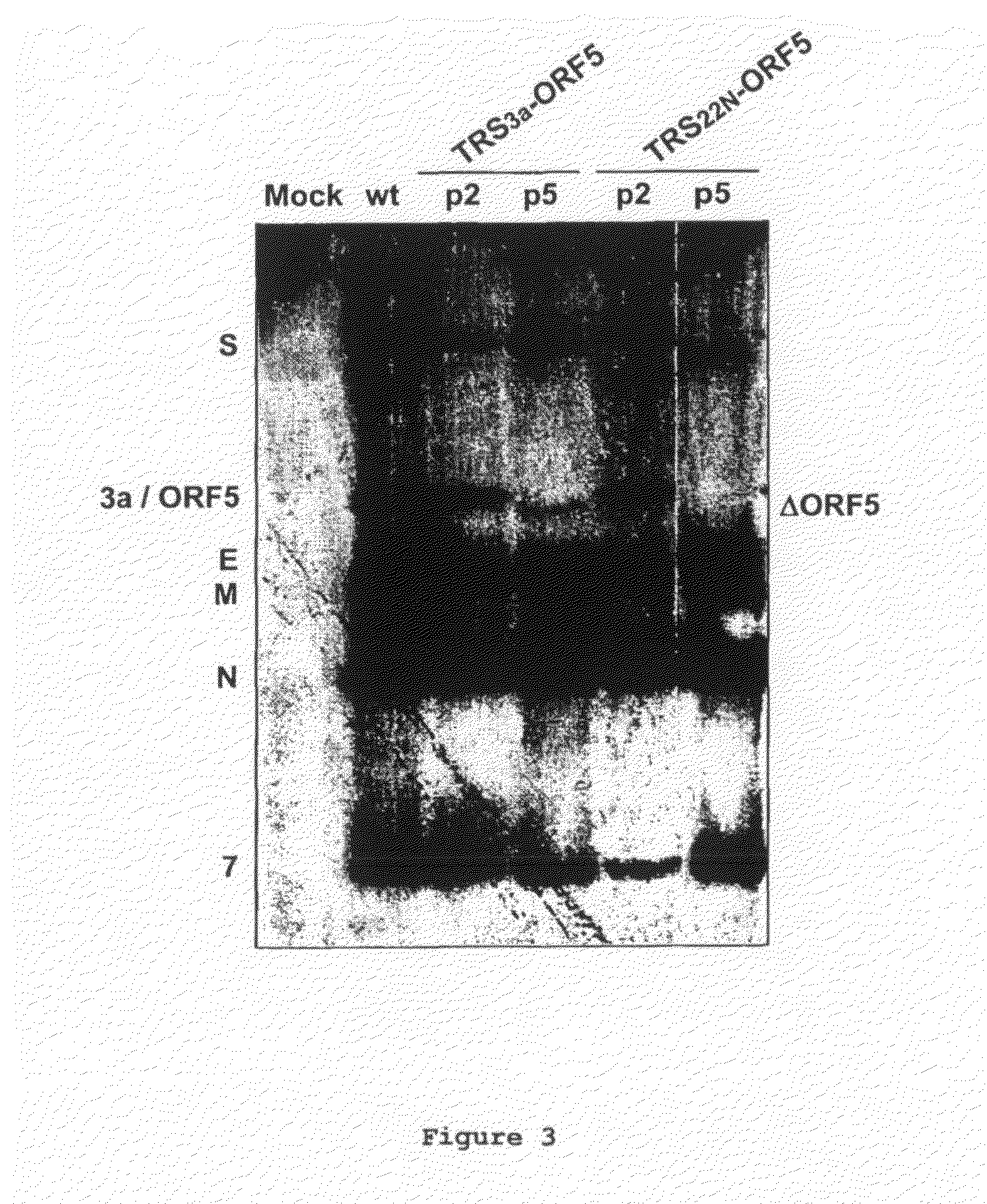Nucleic Acid Encoding TGEV and PRRSV Sequences for Improved Expression of PRRSV Sequences
a technology prrsv, which is applied in the field of nucleic acid encoding tgev and prrsv sequences for improving the expression of prrsv sequences, can solve the problems of reducing the effectiveness of prrsv vaccines, reducing the effectiveness of infection and disease prevention, and reducing the effect of symptoms
- Summary
- Abstract
- Description
- Claims
- Application Information
AI Technical Summary
Benefits of technology
Problems solved by technology
Method used
Image
Examples
example 1
Growth of Eukaryotic Cells
[0137]TGEV growth, titration, and purification were performed in ST (swine testicle) cells, a cell line obtained from epithelial cells of fetal pig testicles (MCCLURKIN and NORMAN, 1966). ST cells were obtained from L. KEMENY (National Animal Disease Centre, Ames, Iowa, USA).
[0138]Plasmid transfections assays were performed in Baby Hamster Kidney cells (BHK-21) stably transformed with the gene coding for the porcine aminopeptidase N (BHK-pAPN) (LAUDE et al., 1990). ST cells were cultivated in DMEM (Dulbecco's Modified Eagle Medium) supplemented with 10% fetal calf serum (FCS) (GIBCO-BRL), 50 mg / mL gentamicine, 2 mM glutamine, and 1% non-essential amino acids.
[0139]The BHK-21 stably transformed with the gene encoding for the porcine aminopeptidase N (BHK-pAPN) were grown in DMEM (Dulbecco's Modified Eagle Medium) supplemented with 2% fetal calf serum (FCS) (GIBCO-BRL), 50 mg / mL gentamicine, 2 mM glutamine, and 1% non-essential amino acids and Geneticine (G41...
example 2
Transformation of Bacteria by Plasmid Electroporation
Bacterial Strains:
[0140]Escherichia coli DH10B (Gibco / BRL) (HANAHAN et al., 1991) was the host for all the plasmids constructed. The genotype of this bacterial strain is: F˜mcr A Δ (mrr-hsdRMS-mcrBC) φ80dlacZΔM15 ΔlacX74 deoR recA1 endA1 araD139 (ara,leu) 7697 galU galK λ− rspL nupG.
Preparation of Electroporation-Competent Bacteria:
[0141]For amplification and production of electroporation-competent E. coli DH10B bacteria, the bacteria were grown in a SOB medium. 10 mL of SOB medium (20 g / L tryptone, 5 g / L yeast extract, 0.5 g / L NaCl) were inoculated with a colony from a fresh plate and were incubated for 12 h at 37° C. under agitation. With 2 mL of this culture, 1 L of SOB medium was inoculated, and the culture was grown at 37° C. to an optical density of 600 nm between 0.8 and 0.9 absorbance units. Then the culture was cooled on ice for 20 min, and the bacteria were centrifuged in the Sorvall GSA rotor at 4.000×g for 15 min at 4°...
example 3
Plasmids for Cloning of PCR Products
[0144]The pGEM-T (Promega) plasmid was used to clone PCR products. This plasmid contains the T7 and SP6 bacteriophage promoters separated by the LacZ gene, interrupted by two protuberant T sequences between a multicloning sequences. This plasmid confers ampicillin resistance for its selection.
PUM
| Property | Measurement | Unit |
|---|---|---|
| pH | aaaaa | aaaaa |
| volume | aaaaa | aaaaa |
| diameter | aaaaa | aaaaa |
Abstract
Description
Claims
Application Information
 Login to View More
Login to View More - R&D
- Intellectual Property
- Life Sciences
- Materials
- Tech Scout
- Unparalleled Data Quality
- Higher Quality Content
- 60% Fewer Hallucinations
Browse by: Latest US Patents, China's latest patents, Technical Efficacy Thesaurus, Application Domain, Technology Topic, Popular Technical Reports.
© 2025 PatSnap. All rights reserved.Legal|Privacy policy|Modern Slavery Act Transparency Statement|Sitemap|About US| Contact US: help@patsnap.com



